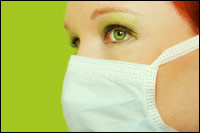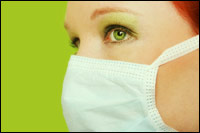The irony is almost too obvious to state: tens of thousands of hospitals, doctors’ offices, medical laboratories, and assorted other health-care providers spew toxic substances into the environment, or dispose of trash containing a noxious mix of contaminated or infectious waste. Some of it will make its way into the air, water, and soil. All of it potentially endangers the health of people and other living things.

Mask not what you can do for your country.
Photo: iStockphoto.
Talk about a health-care crisis.
For years, the health-care sector — which employs more than 10 million people in the U.S. and garners roughly one in seven dollars generated in the economy — didn’t pay much heed to the environmental impacts of its operations. And when it did, it tended toward paper recycling and other modest efforts — Band-Aid solutions, as it were.
But that’s quickly changing, as activists, regulators, and concerned health professionals come to understand that the industry needs some environmental CPR. A variety of events, initiatives, and trends have helped shape the shift: community groups have pressured hospitals and labs to shut down or not build medical-waste incinerators, which can be a significant source of carcinogenic dioxin emissions and other pollutants; activists and public-health officials have raised public awareness and concern over the use of plastics and mercury, among other commonly used medical materials; researchers and think tanks have given the sector’s environmental impacts far more scrutiny than ever before, quantifying its contribution to air and water pollution as well as solid and hazardous waste; groups of enlightened doctors, nurses, and allied professionals have convened meetings and developed networks on the greening of health care, helping to propagate awareness of the problems and their solutions; and the U.S. EPA and other regulators have pitched in with partnerships, voluntary programs, and information resources.
Such a convergence is taking place none too soon. The issues surrounding the greening of health care will require a concerted effort among all parties to overcome the institutional barriers.
Toxic Buy-Products
Consider procurement. Hospitals don’t shop like we do. They rely on group purchasing organizations, or GPOs, that buy medical and surgical equipment on their behalf. So they’re committed to dealing with the suppliers that their GPO relies on, sometimes locked into years-long contracts. If a given GPO uses eco-unfriendly products and a hospital wants to go a different route, the hospital could face a financial penalty for breaking its contract, or may have to wait to make changes until the contract is up for renewal.
Purchasing is just one hurdle health-care facilities must clear to improve their environmental performance. Like other businesses, they must grapple with segregating waste for recycling and other disposition. But hospitals and doctors’ offices face a special challenge in this arena, because potentially infectious medical waste — every bed pan, set of gloves, syringe, swab, blood bag, and intravenous tube — is regulated and must be “red-bagged” — that is, placed in red containers for proper disposal through a third party.
The problem — and this will sound depressingly familiar to many managers — is that keeping health-care workers educated about what trash to throw where is a never-ending battle. The result: people red-bag everything, just to be sure. However prudent a move this may be, it can raise hospitals’ disposal costs significantly by requiring tons of additional trash to be specially handled. (It also turns out that many red bags themselves are hazardous, because they are dyed using cadmium, a highly toxic chemical. Cadmium-free red bags are now on the market.)
As in many businesses, there’s the janitorial issue — but to an extreme degree, due to the need for sterility. And then there’s the problem of weaning doctors and others from time-proven products and materials, such as PVC bags used for blood and other intravenous solutions, and devices containing mercury — including thermometers and blood-pressure units — which, when they break or are discarded, can contaminate air, soil, and water.
The Road to Wellness
Sound like a hopeless case? Fortunately, there are ready alternatives, and a variety of organizations are actively seeking to educate doctors and others about their availability and use. And they’re making progress. Some examples:
- As part of a comprehensive waste-reduction program, Albany Medical Center in Albany, N.Y., built a distillery in 1995 that converts waste alcohol, formalin, xylene, mineral spirits, and paint into products the center can use in its labs. In its first 10 years of operation, the distillery reclaimed 147 tons of chemicals, valued at more than $1 million.
- Kaiser Permanente, the country’s largest nonprofit health-care provider, has its own guidelines for clean and ethical operations and an executive-level position for resource conservation. Kaiser also has a “green team” that collaborates with manufacturers on targeted products.
- Seeking to become mercury-free, Spectrum Health’s Butterworth Campus in Grand Rapids, Mich., instituted a purchasing policy stating that whenever possible, the hospital must buy mercury-free products. It also replaced blood-pressure gauges with those containing a mercury-free alternative, and stopped sending traditional thermometers home with new mothers.
- Dominican Hospital in Santa Cruz, Calif., takes used, clean supplies and, rather than throwing them out, distributes them to the community through its “DominAgain” store. Surgical drapes that would have been landfilled become painters’ tarps, scrub brushes are used by cooks to clean vegetables, and small jars become paint canisters in local schools. The hospital either gives materials away or exchanges them for small donations.
It will take years to get every health-care facility following these leaders, of course. But the treatments seem to be working, and the prognosis for recovery is good.
Rx for Information
Needle little more information? Check up on these resources: Green Guide for Health Care, Healthcare Without Harm, Healthcare Environmental Resource Center, Hospitals for a Healthy Environment, and the Sustainable Hospitals Project.


